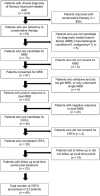The efficacy and safety of cooled-radiofrequency neurotomy in the treatment of chronic thoracic facet (zygapophyseal) joint pain: A retrospective study
- PMID: 32243409
- PMCID: PMC7440134
- DOI: 10.1097/MD.0000000000019711
The efficacy and safety of cooled-radiofrequency neurotomy in the treatment of chronic thoracic facet (zygapophyseal) joint pain: A retrospective study
Abstract
Anatomic course of medial branches in the thoracic spine is significantly different. Cooled RFA (CRFA) is a newer technique that can create a larger spherical lesion with a potential to compensate for the anatomic variability of the medial branches in the thoracic spine. Our retrospective study aimed to investigate the efficacy and the adverse effects of the CRFA in the treatment of thoracic facet-related pain.For this retrospective study, we evaluated 40 CRFA performed on 23 patients. The patients with diagnosis of thoracic facet joint-related pain underwent CRFA. Pain scores in numeric rating scale (NRS) were recorded at pretreatment and posttreatment at different time-points. The primary outcome measure was to report descriptive NRS score and average % improvement from baseline at each time point. A significant pain relief was determined by a decrease of ≥ 50% of mean NRS. Secondary outcome measure was the time to repeat treatment with subsequent CRFA. Adverse events were also recorded.Improvement of average pain level was 20.72% in the 1st follow-up (FU) (4-8 weeks), 53% in the 2nd FU (2-6 months), and 37.58% in the 3rd FU (6-12 months). Subgroup analysis was done based on age cutoff (age in years ≤ 50 versus >50), and pretreatment NRS (≤7 versus >7). Patients with age ≤50 and NRS score >7 experienced the best pain relief in the 2nd FU period (2-6 months). The patients with age > 50 and NRS pain level ≤7 showed steadily increased benefit both in the 2nd FU (2-6 months) and 3rd FU (6-12 months).This is the first clinical study to evaluate the efficacy and adverse effects of CRFA in the thoracic spine for facet joint-related pain. Our results suggest that CRFA procedure is an effective treatment modality for thoracic facet-related pain. Our subgroup analysis demonstrated that the pain relief and duration varies with the age and the pretreatment pain levels.
Conflict of interest statement
The authors have no conflicts of interest to disclose.
Figures






Similar articles
-
Cooled-radiofrequency neurotomy for the treatment of chronic lumbar facet (zygapophyseal) joint pain: A retrospective study.Medicine (Baltimore). 2021 Dec 30;100(52):e28459. doi: 10.1097/MD.0000000000028459. Medicine (Baltimore). 2021. PMID: 34967387 Free PMC article.
-
The response to radiofrequency neurotomy of medial branches including a bipolar system for thoracic facet joints.Scand J Pain. 2018 Oct 25;18(4):747-753. doi: 10.1515/sjpain-2018-0048. Scand J Pain. 2018. PMID: 30001215
-
Comparison of alcohol ablation with repeated thermal radiofrequency ablation in medial branch neurotomy for the treatment of recurrent thoracolumbar facet joint pain.J Anesth. 2013 Jun;27(3):390-5. doi: 10.1007/s00540-012-1525-0. Epub 2012 Nov 29. J Anesth. 2013. PMID: 23192698 Clinical Trial.
-
The Effectiveness of Medial Branch Blocks and Radiofrequency Neurotomy in Managing Chronic Thoracic Pain: A Systematic Review and Meta-Analysis.Pain Physician. 2023 Sep;26(5):413-435. Pain Physician. 2023. PMID: 37774177
-
The efficacy of conventional radiofrequency denervation in patients with chronic low back pain originating from the facet joints: a meta-analysis of randomized controlled trials.Spine J. 2017 Nov;17(11):1770-1780. doi: 10.1016/j.spinee.2017.05.006. Epub 2017 May 30. Spine J. 2017. PMID: 28576500 Review.
Cited by
-
Clinical application of ultrasound in thoracic medial branch block and thoracic cooled-radiofrequency ablation: Case report and literature review.Ultrasound. 2024 Sep 18:1742271X241275242. doi: 10.1177/1742271X241275242. Online ahead of print. Ultrasound. 2024. PMID: 39555153 Free PMC article.
-
Traditional versus cooled-radiofrequency neurotomy for the treatment of chronic lumbar facet (zygapophyseal) joint pain.Pain Manag. 2024 Jun 2;14(5-6):305-314. doi: 10.1080/17581869.2024.2377061. Epub 2024 Jul 30. Pain Manag. 2024. PMID: 39076116 Free PMC article.
-
Latest Evidence-Based Application for Radiofrequency Neurotomy (LEARN): Best Practice Guidelines from the American Society of Pain and Neuroscience (ASPN).J Pain Res. 2021 Sep 8;14:2807-2831. doi: 10.2147/JPR.S325665. eCollection 2021. J Pain Res. 2021. PMID: 34526815 Free PMC article. Review.
-
Cooled Radiofrequency Ablation of Thoracic Medial Branches for the Treatment of Chronic Thoracic Pain.Healthcare (Basel). 2025 Jun 18;13(12):1468. doi: 10.3390/healthcare13121468. Healthcare (Basel). 2025. PMID: 40565494 Free PMC article.
-
Third-degree full-thickness burns as a complication of cervical radiofrequency ablation.BMJ Case Rep. 2021 Nov 30;14(11):e245113. doi: 10.1136/bcr-2021-245113. BMJ Case Rep. 2021. PMID: 34848408 Free PMC article.
References
-
- Manchikanti L, Singh V, Datta S, et al. Comprehensive review of epidemiology, scope, and impact of spinal pain. Pain Physician 2009;12:E35–70. - PubMed
-
- Linton SJ, Hellsing AL, Halldén K. A population-based study of spinal pain among 35-45-year-old individuals: prevalence, sick leave, and health care use. Spine (Phila Pa 1976) 1998;23:1457–63. - PubMed
-
- Manchikanti L, Singh V, Pampati V, et al. Evaluation of the prevalence of facet joint pain in chronic thoracic pain. Pain Physician 2002;5:354–9. - PubMed
-
- Engel A, Rappard G, King W, et al. Standards Division of the International Spine Intervention Society. The effectiveness and risks of fluoroscopically-guided cervical medial branch thermal radiofrequency neurotomy: a systematic review with comprehensive analysis of the published data. Pain Med 2015;17:658–69. - PubMed
Publication types
MeSH terms
LinkOut - more resources
Full Text Sources
Medical

